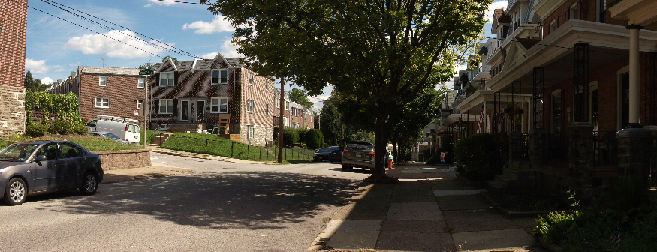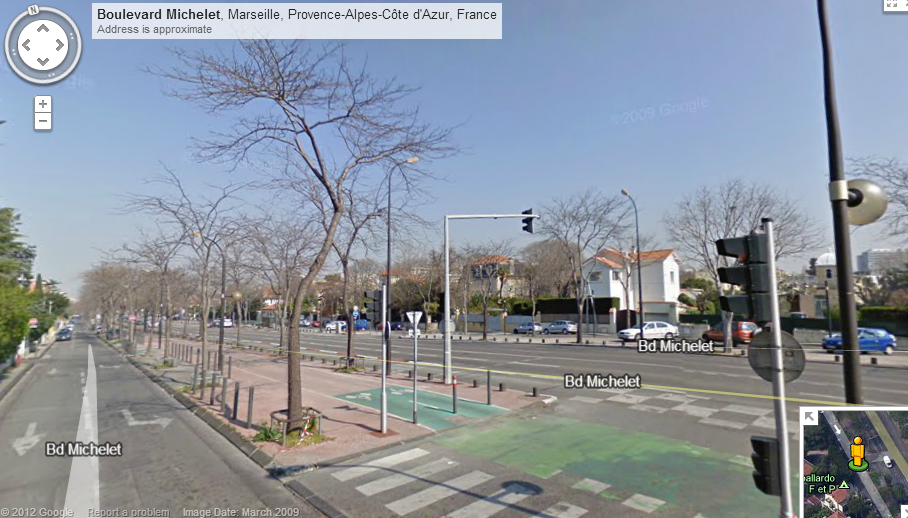Multi-way boulevards appear endemic to places of value in Europe, and rudimentary versions even occur in places of high value in the United States--see, for example, Commonwealth Avenue, Park Avenue, and K Street--but they have yet to be accepted here. Part of this is due to different focuses in transportation planning, engineering, and design: in Europe, a more multi-modal approach became more accepted and, yes, welcomed after the Dutch bike revolution, whereas in the United States the moving-cars-around orthodoxy continued to prevail. In essence, this means American transportation engineering is now a generation behind Europe's.
What I want to explore now are two things: firstly, the variety of configurations available for such boulevards, and secondly, ways to implement transit in the scheme.
What is the Minimum Width?
Stroad to Boulevard carries, essentially, a single cross-section, seen above, for a typical boulevard--100 feet. Of this, two access ways (curbside woonerven) flank a four-lane central artery. Each access way is 28 feet, and the central artery 44 feet, which implies that each driving lane is 11 feet. It is possible to tweak some of the design features--for instance, dropping a foot off each of the central passing lanes (not meant for trucks anyway) and adding it to the access lanes. As woonerven, the access area fulfills primary pedestrian and cyclist needs and secondary auto ones (primarily loading and parking)--to function, in other words, as a street--while the central artery is able to function as a road.
We'll call this full profile--bidirectional, with twin woonerven. It is intuitive that this would be optimal for 100-foot arteries, such as Broad and Market streets.
 |
| Ignore the school bus. There would be no bus lanes at this standard. |
If you split this in two, you would get a half-profile boulevard. The narrowest this could be would be 38 feet (or a more comfortable 40 feet)--assuming no pedestrian realm at all to one side. Add a sidewalk and you've got 50 feet.
The problem with this, however, is that
So we can say the narrowest useful multi-way boulevard is 80 feet. This actually works well for most American cities, which tend to have wider streets that can better support this treatment.
Adding Transit to the Scheme
Most European multi-way boulevards have buses running in the outer through lanes, and some have light rail in the median--see this example from Rotterdam. Such boulevards can have truly tremendous widths--Rotterdam's Schiekade looks to be, for example, some 160 feet wide--but we are focused on developing light rail along boulevards of more manageable width.
Girard Avenue is a good example: The 15 trolley runs in the median of what is here a 120-foot street. This represents an easy insertion into the 100-foot multi-way boulevard standard--see above. Likewise, a transit median on a 100-foot multiway boulevard, like would be a relatively simple insertion into the 80-foot standard--see below. Washington Ave. would be a good possibility for this treatment--see below.
The problem comes when you need to put a transit median into an 80-foot way, like Baltimore Avenue. Without the trolley median, it would be equivalent to 60 feet, too narrow for a full boulevard. Could a sacrifice need be made? Just the woonerven--Stroad to Boulevard shows us the way. While that post is about 66-foot streets, a crop of three feet on both sides brings us down to 60 feet, enough to insert the 20-foot transit median in between. This is, again, perfectly encapsulated in Rotterdam, on the Middellandstraat:
Even where the street is too narrow to support full access woonerven, it's still possible to support a transit median. But what about 60-foot streets, like Germantown Avenue? This final class does require a sacrifice--Do you give mass transit a dedicated right-of-way and cut parking? Or do you mix traffic in two travel lanes and provide it? Both solutions require a tradeoff: with the former you have better throughput on all modes, but most constituencies demand parking and reject any proposal reducing it, Shoup be damned.
So in conclusion, we can say that, firstly, the nature of a multi-way boulevard makes 76 ft. its absolute minimum, as that width has two driving lanes coupled with mirrored woonerven; this can be retranslated into an 80-foot standard for most American municipalities; secondly, that the addition of transit lanes blows the width out a bit, and that a 100-foot transit boulevard is analogous to an 80-foot multi-way boulevard, 120 to 100, and so forth; thirdly, that transit provision on sub-100-foot streets requires a transit avenue, built like a Dutch complete street; and fourthly, that at 60 feet a tradeoff must be made between throughput and parking.
While this post is by no means perfect, consider it a framework for applying transportation engineering and urban design to the streetscape; consider it a framework for implementing European design standards in American situations.








